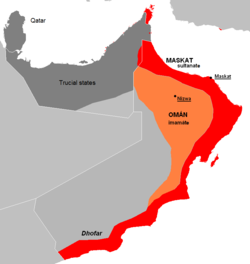
Back إمامة عمان Arabic Oman imamlığı AZ Imamat d'Oman Catalan Imamát Omán Czech Imanato de Omán Spanish Omango Imamerria EU امامت عمان FA Imamat d'Oman French Keimaman Oman ID Imamato di Oman Italian
Imamate of Oman إمامة عُمَان Imāmat 'Umān | |||||||||||
|---|---|---|---|---|---|---|---|---|---|---|---|
| 749–1959 | |||||||||||
| Motto: ٱللَّٰهُ أَكْبَرُ God is the Greatest | |||||||||||
 The last Imamate of Oman and the Sultanate of Muscat in the 20th century | |||||||||||
| Status | Imamate | ||||||||||
| Capital | Nizwa 22°56′N 57°32′E / 22.933°N 57.533°E | ||||||||||
| Common languages | Arabic | ||||||||||
| Religion | Ibadi Islam (state religion) | ||||||||||
| Government | Islamic theocratic elective monarchy | ||||||||||
| Imam | |||||||||||
• 749–751 (first) | Al-Julanda bin Masud | ||||||||||
• 1954–1959 (last) | Ghalib al-Hinai | ||||||||||
| Legislature | Consultative Council | ||||||||||
| Historical era | Dissolution of the Ottoman Empire/New Imperialism | ||||||||||
• Imamate declared | 749 | ||||||||||
| 25 September 1920 | |||||||||||
• End of the Jebel Akhdar War | 1959 | ||||||||||
| Currency | Maria Theresa thaler[1] | ||||||||||
| ISO 3166 code | OM | ||||||||||
| |||||||||||
| Today part of | Oman | ||||||||||
The Imamate of Oman (Arabic: إِمَامَة عُمَان, romanized: Imāmat ʿUmān) was a historical state within the Oman proper (Arabic: عُمَان ٱلْوُسْطَى, romanized: ʿUmān al-Wusṭā, lit. 'Central Oman') in the Hajar Mountains, part of the present-day Sultanate of Oman.[2] The capital of the Imamate alternated historically between Rustaq and Nizwa. The Imamate's territory extended north to Ibri and south to the Alsharqiyah region and the Sharqiya Sands. The Imamate was bounded in the east by the Hajar Mountains and in the west by the Rub' al Khali (Empty Quarter) desert.[3] The Al Hajar Mountains separated the Imamate of Oman from Muscat and Oman. The elected Imam (ruler) resided in the capital, and Walis (governors) represented the Imamate in its different regions.[4][5][6]
The Imamate of Oman, similar to the Sultanate of Muscat, was ruled by the Ibadi sect. Imams exercised spiritual and temporal representation over the region.[3] The Imamate is a 1,200-year-old system of government pioneered by the Ibadi religious leaders of Oman, and was based upon the Islamic sharia. The Imamate holds that the ruler should be elected.[5] The imam is considered as the head of the community but tribalism that is part of the Omani society encouraged a decentralised form of governance that would help sustain political unity among the Omanis.[3] The Imamate set out a government system wherein the ruler should not have absolute political nor military power; rather power should be shared with local governors.[6] To prevent local or external threats to the Imamate, the imam had to gather the support of the local communities and tribes to raise a force to fight for a certain cause. The imam needed in-depth understanding of tribal politics and political acumen to maintain political stability within the Imamate when conflicts occurred.[3]
- ^ El-Sohl, Raghid (1997). Oman and the South-Eastern Shore of Arabia. p. 63. ISBN 978-0-86372-199-1. Retrieved 4 December 2023.
- ^ "FO 1016/313 The Imamate of Oman: report by George Rentz p.44". agda.ae. Retrieved 1 September 2021.
- ^ a b c d Oman's Foreign Policy: Foundation and Practice: Foundation and Practice by Majid Alkhalili
- ^ Historical Summary of Events in the Persian Gulf Shaikhdoms and the Sultanate of Muscat and Oman, 1928–1953' [97v] (199/222) QDL.
- ^ a b British National Archive: (18/316) Muscat State Affairs: Muscat– Oman Treaty
- ^ a b Oman and the World: The Emergence of an Independent Foreign Policy (Joseph A. Kechichian)

